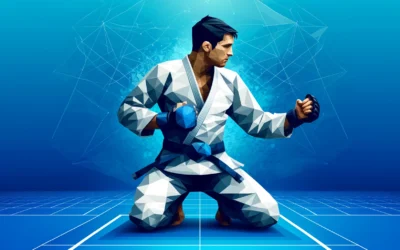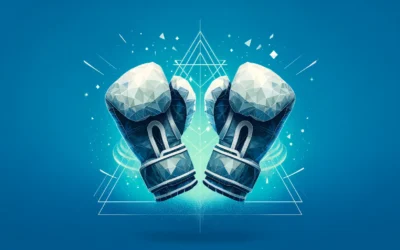Stance in mixed martial arts is the foundation for effective striking. This fundamental positioning allows fighters to move, defend, and generate power. We’ll look in-depth at how proper stance facilitates success across martial arts.
Establishing Your Base: The Mechanics of Stance
Every combat sport utilizes some form of stance. From narrow boxing postures to wide karate positions, the footing is customized to the technique.
Staggering the feet opens up movement in all directions. Mobility, stability, and power stem from this balanced platform.
Key Elements
- Feet are staggered, not planted side by side
- Front foot faces opponent, back foot is turned out
- Allows rapid movement forward, backwards, left and right
- Braces core for impact, increasing stability
- Generates torque for powerful striking
The lead leg and rear leg are oriented asymmetrically. Facing the front foot forward puts the hips in a position to drive into techniques.
Having the back foot perpendicular unlocks lateral motion. Quick, minor adjustments maintain optimal positioning.
Stance facilitates dynamic footwork. Fighters can explode forward to enter range or bounce back out of danger. Sidesteps, pivots, and circling are all enabled by the proper base.
The staggered stance also braces the upper body for impact. With the feet planted evenly, strikes are far more likely to cause a knockdown.
When firmly rooted, fighters can roll with punches effectively. Less force transmits to the head and body with a proper foundation underneath.
Ingraining the Stance
Stance is the very first skill taught to beginners for a good reason. Constant repetition develops the neuromuscular pathways to hold proper positioning reflexively.
Drilling basic movements like forward and backward steps, lateral slides, and pivots ingrain balance. Stance should remain steady even during rigorous motion.
Spending time in stance develops necessary strength. Proper form prevents excessive tension, while still building athletic bases.
Fighters use their stance throughout practice and competition. Even the most experienced competitors revisit this fundamental to sharpen technical proficiency.
Generating Power: Stance and Striking
The stance facilitates optimal transmission of force into strikes. Effective punching and kicking rely heavily on hip rotation and weight transfer.
Rotational Force
Hip torque multiplied by body mass creates tremendous kinetic energy. Punching power depends more on the hip drive than arm strength.
Stance allows combatants to rotate the torso separate from the hips for maximal rotational force. Twisting the hips then adds even more.
Karate fighters exemplify this by sinking into long stances and then unleashing punches with coordinated hip and shoulder turns.
The back foot pivots to turn the hips over on hooks and uppercuts. Having feet staggered instead of square unlocks this movement.
Weight Transfer
Shifting weight from the rear to the lead transfers power up the kinetic chain. This links the force generated in the lower body to the arm.
For lead hand strikes like the jab or hook, the weight accelerates reversely. Force flows from the front foot to the rear heel.
Knockout power requires optimal weight transfer. Stance facilitates driving weight into punches for maximum impact.
Disrupting Stance
Taking away an opponent’s stance hampers offence. Clinching or pressuring them to the ropes prevents proper footwork.
Limiting mobility and leverage reduces striking power. Fighters pressed against the cage cannot rotate their hips fully or shift weight.
However, this doesn’t completely eliminate punching power. Crafty competitors use frames to create just enough space for short hooks or uppercuts.
The disadvantages of a compromised stance typically outweigh potential opportunities. Fighters should look to regain positioning, not trade blows.
Holding Ground: Stance for Defense
A proper stance also facilitates defensive techniques needed to avoid getting hit cleanly or remaining upright when struck.
Head Movement
Good footing allows fighters to slip punches or pull the head back just enough to avoid impact. Rotating the lead foot opens up lateral motion.
With feet staggered, the upper body can move freely. Having a static base underneath makes slips and rolls more effective.
Angling off is also dependent on solid stance. Quick steps change position while maintaining balance to make opponents miss.
If punchers overcommit, fighters can pivot into the opening created. Their strong base allows changing direction suddenly.
Taking Shots
When strikes do land, stance helps prevent knockdowns. Having flexible knees allows rolling with shots to dissipate force.
In muay thai, fighters will block kicks then push back against the striking leg to prevent being pushed off balance. This requires rooted footing.
The adage “head moves, body stays still” depends on proper stance. Strikes turn the head independently of the feet staying planted.
By staying grounded, fighters can regain composure quicker after big shots. Stance recovery prevents opponents from overwhelming them.
Regaining Footing
If taken down or pressed against the cage, fighters work urgently to regain their stance. Creating space lets them reestablish optimal positioning.
Frame and pummel drills develop this skill. Technical stands into underhooks reorient footing to land strikes. Pivoting off the cage returns control.
Until they can create distance, fighters should stay defensive. Attempting to throw power with compromised stance often backfires.
The most dangerous strikers use angles, footwork, and frames to take back their stance immediately when disrupted. They rarely stay pinned for long.
Adapting Stance: Strategic Considerations
While there are commonalities in stances across disciplines, each fighter must find optimal positioning for their attributes.
Customizing Footwork
Short fighters may take wider stances and stay at long range. Taller kickboxers can narrow their base to provide additional forward and backward movement.
Strikers must also adapt footwork for southpaw opponents. They may change stances or modify lead feet positioning to maintain angles.
Stances against aggressive opponents tend to become more lateral, with protective lead shoulders and retracted chins. Blitzing counters require more square positioning.
Testing stance variations in training reveals personalized advantages. Tailor footing to preferred tactics rather than blindly adhering to textbook form.
Shifting Strategically
Fighters change stances mid-fight to open up new striking angles, confuse opponents, and manage fatigue.
Switching from orthodox to southpaw against a rear-foot-heavy fighter may expose their lead leg for kicks.
Alternating stances can also disguise intentions and set up unexpected attacks. Opponents may be anticipating specific counters that changing footing eliminates.
Fighters can swap stances when fatigued to give the back leg a break. This allows muscles on the lead side to recover briefly.
The best competitors integrate stance shifting seamlessly into their game plans. They hesitate or overthink changes.
Stance in Mixed Martial Arts is the Foundation
Combatants owe their ability to move, strike, and defend to the humble stance. Mastery opens up the entire standup arsenal.
At Apex MMA, Muay Thai & Jiu-Jitsu, students dedicate themselves to perfecting foundational techniques like stance. Try our free 7-day trial to begin honing this critical skill.
The proper stance facilitates dynamic striking and defence in MMA, boxing, karate, and other martial arts. Refine this elemental building block to unlock your full potential.





0 Comments